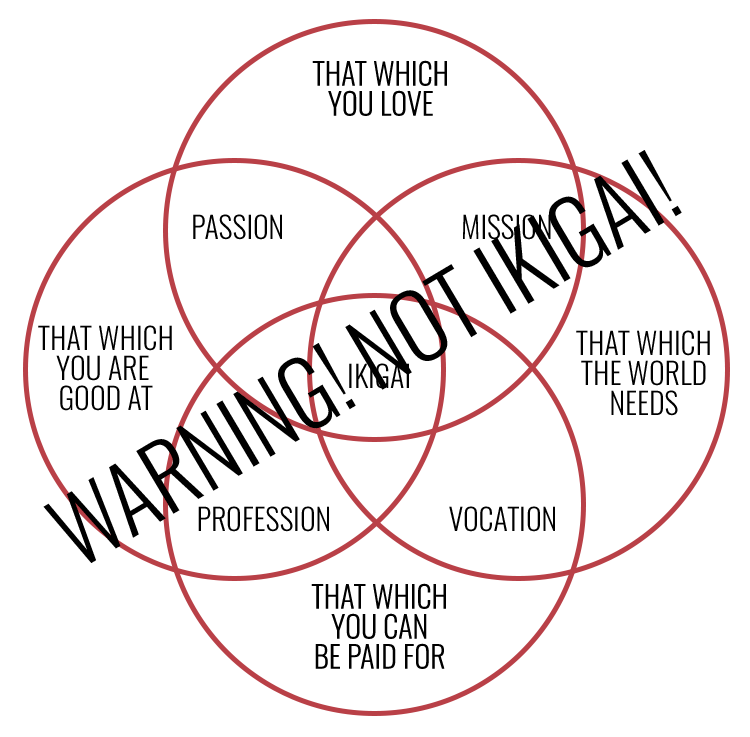LOOKING FOR IKIGAI WORKSHEETS?
Are you currently using—or thinking of using—the Ikigai Venn diagram to coach clients, lead workshops, or deliver keynotes?
If so, you may be unintentionally oversimplifying a rich and culturally rooted concept. While the Venn diagram can be visually engaging and useful in certain contexts, it is not of Japanese origin. In fact, it contradicts the depth, nuance, and lived meaning of ikigai as it is understood in Japan.
WESTERNISED IKIGAI CHART

Get The Coaching With Ikigai Worksheets
Download the ikigai worksheets below. They will help you understand what ikigai means and how to coach it.
The "Ikigai Venn Diagram"

Ikigai & Ikigai-Kan

Ikigai Exercises

The Ikigai-9

This set of Coaching with Ikigai worksheets offers you a more accurate and respectful approach. Inside, you'll find:
- A clear, culturally grounded definition of ikigai
- A validated psychometric tool (the Ikigai-9) for use in coaching
- Insightful coaching questions aligned with Japanese psychological research
- A deeper understanding of ikigai as a lived experience
Explore how you can bring greater authenticity and depth to your coaching practice by engaging with ikigai the way it is truly lived and understood in Japan.
The Ikigai Venn Diagram
The Venn diagram below and literally thousands of copies of it is what you will find on the internet when you google ‘ikigai’ . This is NOT Ikigai. This is not what ikigai means to the Japanese. They do not use this framework, and Japanese do not contemplate the four questions in the framework when they think of their ikigai. This framework is just one blogger’s interpretation (misinterpretation) of ikigai. In fact, in his own words:
“In 2014, I wrote a blog post on the subject of Ikigai. In that blog post, I merged two concepts to create something new. Essentially, I merged a venn diagram on ‘purpose’ with Dan Buettner’s Ikigai concept, in relation to living to be more than 100. The sum total of my effort was that I changed one word on a diagram and shared a ‘new’ meme with the world. “ - Marc Winn
Marc Winn's Ikigai Vann Diagram

Ikigai Is Not About….
It’s not about making money.
Ikigai is not the pursuit of professional success or financial freedom. Most Japanese would not associate making money with ikigai. Success and the accumulation of wealth could be a by-product of your ikigai, but it would not be the focus.
It’s not what the world needs from you.
Ikigai is not about what the world needs from you. Ikigai lies in the realm of community, family, friendships and in the roles you fulfill. When you pursue your ikigai, you are not out to save the world. It is more about connecting with and helping the people who give meaning to your life - your family, friends, co-workers and community.
It’s not about what you are good at.
You don’t have to be good at something to find your ikigai. Ikigai can be a very simple practice, a daily ritual or the practice of a new hobby. Ikigai is more about growth rather than mastery.
It’s often not about what you love.
Ikigai can be something you love or are passionate about, but to the Japanese ikigai is more associated with purposeful living.
You can find ikigai in areas of your life you would least expect. Also, ikigai can find you.
Understanding Ikigai
As previously mentioned, the biggest misconception of ikigai is that it is a sweet spot of our professional life, where we achieve our one true purpose on a grand scale. We need to be careful about how we think about our ikigai. It is not a destination or goal to achieve. It does encompass goals, but with ikigai there is no destination.
Ikigai is not about what you want out of life. Ikigai is about who you want to become - your actualized self. This is why ikigai is personal and also for many people private. And it is considered by some Japanese as the most honorable thing one can do.
Ikigai vs Happiness
How is ikigai different to happiness?
If we understand and define happiness as fleeting moments of joy, delight and peace in the present, then ikigai is more in line with the characteristics of eudaimonia, the condition of human flourishing or of living well.
For Japanese, feeling ikigai is close to eudaimonic well-being. In fact, Japanese would only comprehend eudaimonic well-being with the word ikigai.
Feeling ikigai entails actions of devoting oneself to pursuits one enjoys and is associated with feelings of accomplishment and fulfillment. Furthermore, it includes awareness of values such as the purpose of life and the meaning of existence; it is future oriented, as in goal seeking.
Also, Ikigai is more frequently associated with actions, especially the doing of things one enjoys. This is why it is important to remember that in order to find or experience one’s ikigai we need to be proactive.
Future & Goals
Ikigai is future oriented and long-term, and as such involves the pursuit of goals. As goals are personal, meaningful and involve effort and persistence, the pursuit of them can lead to a sense of well-being. And goals give us a sense of purpose, thus pursuing them makes life worth living.
An important point to make about goals in relation to ikigai is the achievement of them is not as important as the process and effort that goes into them. For many Japanese, Ikigai has an inextricable link to a concept called kodawari, doing things properly with great attention to detail. The dedication to a process and the commitment to progress is more important than the achievement of any goal to practitioners of kodawari.
Also these goals don’t need to be impressive and driven by the ego. For many Japanese, their ikigai can be the humble pursuit of a seemingly meaningless goal.
